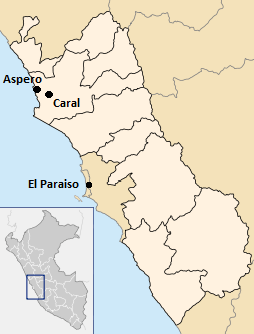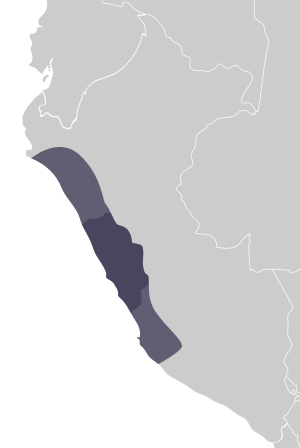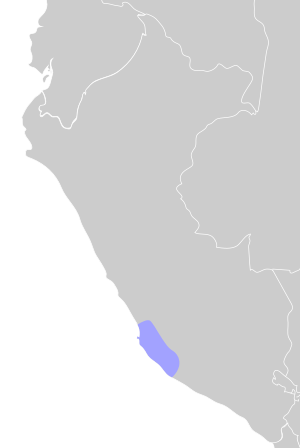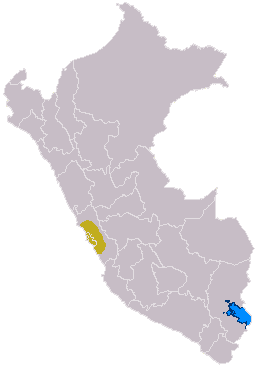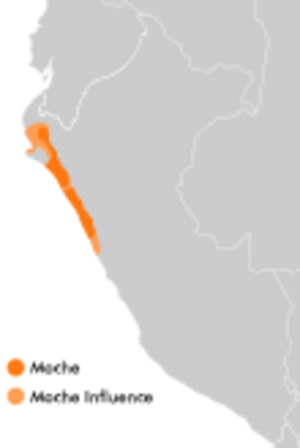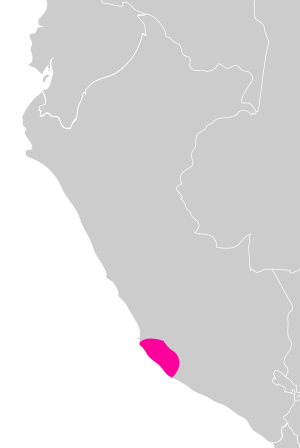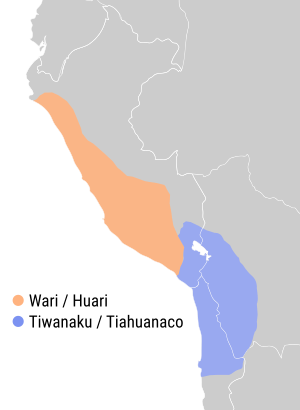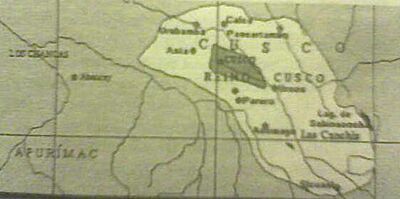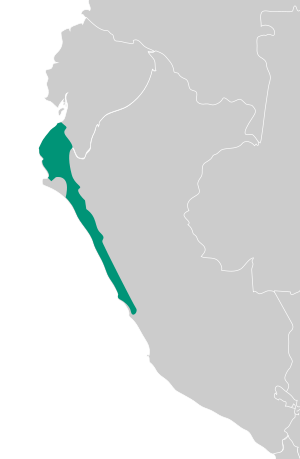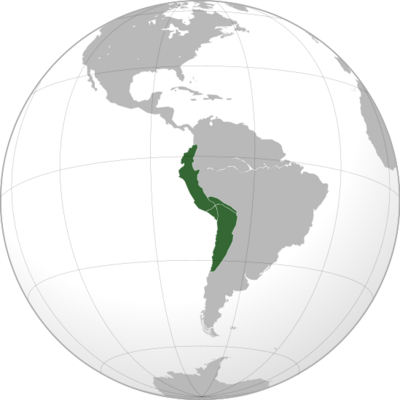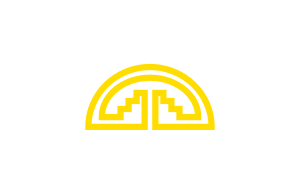History of Andean South America facts for kids
The history of people living in the Andes mountains of South America goes back about 17,000 years, right up to today. This huge region is 7,000 kilometers (4,300 miles) long. It includes mountains, tropical areas, and deserts. The unique land and weather here greatly shaped how people settled and lived, leading to special cultures and societies.
The first humans arrived in South America from Central America, crossing a narrow land bridge called the Isthmus of Panama. These early people were hunter-gatherers, meaning they hunted animals and gathered wild plants for food. The oldest signs of people living in the Andes date back to about 15,000 BCE. This time is called the Lithic Period.
Later, during the Pre-Ceramic Period, people started growing plants more widely. The first complex society, the Caral-Supe civilization, appeared around 3500 BC. It lasted until 1800 BC. Important religious places also began to emerge, like the Kotosh Religious Tradition in the highlands.
After this came the Ceramic Period, when people learned to make pottery. Many advanced societies grew during this time. Some famous ones include the Chavín culture (900 BC to 200 BC), the Paracas culture (800 BC to 200 BC), and its successor, the Nazca culture (200 BC to 800 AD). Other groups were the Moche civilization (100 to 700 AD), the Wari and Tiwanaku Empires (both 600 to 1000 AD), and Chimor (900 to 1470 AD).
Later, the Incas conquered much of the Andean region. In 1438, they created the largest empire the Americas had ever seen, called Tahuantinsuyu, but usually known as the Inca Empire. The Inca ruled from their capital city, Cuzco, following traditional Andean ways. The Inca Empire grew from the Kingdom of Cuzco, which started around 1230.
In the 1500s, Spanish explorers from Europe arrived in the Andes. They eventually took control of the native kingdoms and made the Andean region part of the Spanish Empire. In the 1800s, a strong feeling of wanting freedom from foreign rule spread across South America. Rebel armies fought and ended Spanish control.
The Andean region then split into several new countries: Peru, Chile, Bolivia, and Ecuador. In the 1900s, the United States became more involved in the region, often for its natural resources like natural gas. This led to the rise of movements that opposed U.S. and large company involvement in Andean South America.
Contents
Stone Tool Period: About 15,000 BCE to 3500 BCE
The earliest time when humans lived in the Andes is called the Lithic Period. It is also known as the Early Archaic period. During this time, people mainly used stone tools for everything. They lived as hunter-gatherers, finding their food from nature.
First People Arrive
Early humans first appeared in East Africa around 200,000 years ago. They slowly spread across Africa and then into Europe and Asia. From a land bridge called Beringia, which connected Siberia (in Asia) to Alaska (in North America), humans first crossed into the Americas.
From there, groups of people moved south, settling across North America. They eventually reached the Isthmus of Panama and crossed into South America. Scientists have found that all the native people in South America came from one main group of early Americans, known as the Paleo-Indians.
Ancient beliefs across South America suggest that these first Paleo-Indian settlers believed the Earth was in the middle of a universe with many layers. They thought the Earth was held between a sky world above and a cave-like world below.
The first people to explore South America probably avoided the high Andes mountains. The upper parts were covered in ice, very cold, and had little plant life. Also, these early groups would have had trouble breathing at high altitudes (hypoxia). Instead, these first hunter-gatherers likely stayed near the coasts. There, they could use resources from rivers, deltas, and saltwater lagoons.
Slowly, as their numbers grew, these Native Americans spread throughout the continent. Some groups eventually reached the Andean region. They likely first lived in the low coastal areas. They only went into the mountains to find resources like obsidian (a type of volcanic glass). Over time, as their children and grandchildren got used to the high altitude, groups of people began to move up and live in the higher parts of the Andes.
One of the oldest known Andean sites studied by archaeologists is Monte Verde in Southern Chile. It dates back about 14,800 years. At this site, people lived seasonally along a creek in cool pine forests. Archaeologists found preserved wooden and stone tools there. They also found remains of wild vegetables like potatoes. Bones of five or six mastodons were also found, which humans had either hunted or scavenged.
Other important sites from this period in the Andes include Los Toldos (Santa Cruz) in Argentina and San Vicente de Tagua Tagua, Cueva Fell (Fell's Cave), and Quero in Chile. In Peru, sites like Pikimachay, Jaywamachay (40 km southwest of Ayacucho), Huarago, and Uschumachay are also important. Evidence from these sites shows that the horse was the most hunted animal at this time. Sloths and guanacos were also hunted.
Early Ways of Life
Because the Andean region has many different types of land, unique communities developed. They adapted to their specific locations during the later part of the Stone Tool Period. Archaeologists identify these groups by their different stone tool designs. They call them the Northwestern tradition, the coastal Paijan tradition, the Central Andean Lithic Tradition, and the Atacama Maritime Tradition.
It was also during this time that Andean communities first began to grow crops. They slowly changed wild plants into ones they could farm.
Pre-Pottery Period: About 3500 BCE to 2000 BCE
New Societies Form
The Stone Tool Period was followed by what archaeologists call the Pre-Pottery Period. It is also known as the Late Archaic Period. This time saw societies become more complex, populations grow, and the building of large special centers across the Andes. These big buildings are the clearest sign of the Pre-Pottery Period. They show that Andean society was organized enough to manage large building projects and many workers.
The population in the Andes also grew during this period. Many people might have moved around, spending part of the year in rural areas. But they would gather at the large special centers for important events. The Pre-Pottery Period also saw changes in the climate of the Andes. The end of the Ice Age meant that glaciers stopped melting back. As a result, sea levels on the west coast of South America became stable.
Despite these changes, many things stayed the same. For example, as its name suggests, people in the Pre-Pottery Period had not yet developed ceramic technology. So, they had no pottery for cooking or storing food. Also, Andean communities had not yet fully developed agriculture or domesticated many plants or animals. They still got most of their food by hunting or gathering from the wild, just like their ancestors. However, there is evidence that some wild plants were starting to be grown on purpose.
Caral-Supe Civilization
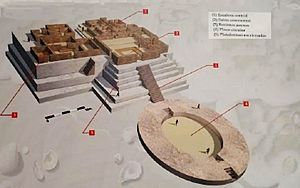
The Caral-Supe civilization was the first major civilization in the Americas before Columbus arrived. It was located in what is now Peru and was one of the world's oldest civilizations. It began around 3500 BC, and large buildings started appearing around 3100 BC. This civilization lasted until 1800 BC. Some of its biggest cities were Caral and Aspero, which is a key site for studying this civilization.
Pottery Period: About 2000 BCE to 1533 AD
New Ways of Life
The start of the Pottery Period is marked by the development of ceramic technology in the Andes. This led to the making of pottery for cooking and storing food. But pottery was just one part of a much bigger change along the Andean coast. Communities started moving away from coastal settlements as their main centers. They preferred places further inland. This meant that the old economy, based on the sea, was replaced by one focused on irrigation farming.
Early Developments
Kotosh Religious Tradition
In the mountain valleys of the Andes, people built many special buildings. Archaeologists call these the Kotosh Religious Tradition. One of the most important sites is Kotosh, which gave the tradition its name. Located by the Río Higueras, Kotosh is about 2,000 meters (6,500 feet) above sea level. It had "two large platform mounds (raised areas) with smaller buildings around them, and other small structures on a nearby river terrace." Another good example is La Galgada in Peru. It also has two platform mounds and other buildings nearby.
In other parts of the Andes, other traditions of building ceremonial monuments also grew during the Pre-Pottery period.
Powerful Earthquake in Chile Around 1800 BC, a very strong earthquake hit Chile, in the Atacama desert area. It was one of the largest known earthquakes, with a strength of about 9.5. This is the same strength as the Valdivia earthquake, the strongest ever recorded. This ancient earthquake caused a tsunami (giant wave) about 20 meters (65 feet) high. The tsunami traveled across the entire Pacific Ocean. It also created a new inland sea in the Atacama desert, which later dried up.
The people living in the area at that time were hunter-gatherers. They likely suffered huge losses. After the earthquake and tsunami, the area was empty for about 1,000 years. This was probably because people remembered the disaster.
Early Horizon Period
Chavin Culture
The Chavin culture was an important civilization during the Early Horizon period. It began in 900 BC and lasted until 200 BC. This culture was known for its strong religious practices. People also started using metallurgy (working with metals) and making textiles (cloth). Farming methods also improved.
Paracas Culture
The Paracas culture was an ancient culture in Peru. It existed from 800 BC to 100 BC. It is famous for its very fine textiles. The Paracas culture was followed by the Nazca culture, which grew from its foundations around 100 BC.
Early Intermediate Period
Lima Culture
The Lima culture was a civilization that lived in the area of the modern-day city of Lima. It existed from 100 AD to 650 AD.
Moche Culture
The Moche culture was a culture in northwestern Peru. It thrived between 100 AD and 700 AD. It was made up of many groups that shared the same culture but ruled themselves. The language thought to be spoken by this culture is Mochica.
Nazca Culture
The Nazca culture was a culture in southwestern Peru. It started around 100 BC, building on the earlier Paracas culture. It is famous for the Nazca Lines, which are huge drawings on the ground called geoglyphs. Their purpose is still a mystery. The Nazca also made textiles and built puquios, which are networks of underground water channels. Some of these are still used today.
Middle Horizon Period
Wari Empire
The Wari Empire was a powerful group in what is now Peru. It began around 600 AD and fell around 1000 AD, at the same time as the Tiwanaku Empire. Its capital city was Huari.
Tiwanaku Empire

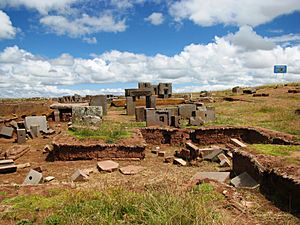
The Tiwanaku Empire was a powerful group that existed in what is now Bolivia. It lasted from 600 AD to 1000 AD. Its capital, Tiwanaku, was one of the largest cities in the Americas before Columbus. In 800 AD, it might have had 10,000 to 20,000 people. It is also known for its amazing stonework, especially at the site of Pumapunku, which is a complex of ruins. Some people don't think it was a true empire. This is because there is no clear proof of ruling families, state-built roads, or markets.
Late Intermediate Period
Kingdom of Cusco
The Kingdom of Cusco was a small kingdom centered around the city of Cusco. It was founded around 1230 by Manco Capac, who was also the first Sapa Inca (ruler). This kingdom was the beginning of the Inca Empire, which was founded in 1438 by Sapa Inca Pachacuti.
Chimor
Chimor was a political group of the Chimor culture. It lasted from 900 AD until the Inca conquered it in 1470. This culture grew from the area of the earlier Moche culture. It was a monarchy, meaning it had a single ruler, and was a unified state. The languages thought to be spoken in this state were Mochica, the language of the earlier Moche culture, and Quignam, the language of the Chimor people.
Aymaran Kingdoms
The Aymara kingdoms were a group of Aymaran political groups that thrived between 1150 and 1477. They appeared after the Tiwanaku Empire collapsed. There were 12 main Aymara kingdoms.
Late Horizon Period
Inca Empire

During the Late Horizon period, the Inca Empire grew to cover the entire Andes region. It was called Tahuantinsuyu, which means "The Four Regions" in the Quechua language.
The empire began in 1438, growing from the Kingdom of Cuzco. Its first emperor was Pachacuti. In the years that followed, under Pachacuti's son Tupac Inca Yupanqui (who ruled from 1471 to 1493), the empire grew very quickly. By the time Columbus arrived in the Americas, it was the largest empire there.
The next emperor, Huayna Capac, ruled until about 1527. He suddenly died from smallpox, a disease brought by Europeans. His death led to a civil war between his sons. This war, along with smallpox, weakened the empire. It was finally conquered by Francisco Pizzaro in 1533. This marked the start of European colonization, and the Andes became part of the Spanish Empire.
Even though the Inca Empire used many ideas and skills from earlier Andean cultures, the Inca rulers did not want to admit this. Instead, they claimed that before their empire, the Andes were only home to simple, warring tribes. They said the Inca tribe brought peace and order.
European Control: 1533 to 1800s
The Andean region became a part of the Spanish Empire.
Wars for Freedom
A very important person in the wars for freedom in Latin America was Simón Bolívar. The country of Bolivia was named after him to show thanks.
After Colonial Rule: 1800s to Today
Modern Developments
In 1969, five Andean countries—Bolivia, Chile, Colombia, Ecuador, and Peru—formed their own trade bloc called the Andean Pact. In 1973, Venezuela joined them. However, in 1976, Chile left the Pact. This was after Chile's President of Chile Augusto Pinochet said the Pact did not fit his right-wing ideas. The Pact was renamed the Andean Community of Nations in 1996.
The "Pink Tide"
In the 2000s, left-leaning presidents were elected in several Andean countries. This was part of a larger movement called the "pink tide" that swept across Latin America. This movement saw political groups on the left gain more power, often in reaction to certain economic policies.
In 2006, Evo Morales from the Movement for Socialism party became President of Bolivia. Later that year, Rafael Correa from the PAIS Alliance was elected President of Ecuador. Both Morales and Correa were socialists. They took control of industries for the government (nationalizing) and opposed the influence of the United States in their countries. Instead, they allied with the government of Venezuela, then led by Hugo Chávez. They joined the Bolivarian Alliance for the Americas, a trade bloc for socialist nations in Latin America.



